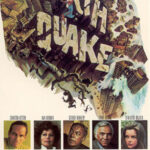What a fun and interesting documentary! An elderly woman trucker'”Teri Horton'”buys a huge painting for $5 at a thrift store, a local art instructor is struck by its resemblance to Jackson Pollock’s work (to which she responds, “Who the f*** is Jackson Pollock?”–hence the title of the film) and suggests it might well be a Pollock, and over a decade later people are still arguing over whether it is or not.
And it makes a pretty big difference, in bottom line terms. If it’s a Pollock, it’s worth $50 million or more. If it’s not, it’s worth, well, probably about the $5 she paid for it.
Though let’s pause and think about that for a moment, because already that raises the question of to what extent the monetary value of a piece of art is a matter of convention, and to what extent it’s a reflection of some objective properties, some inherent merit of the work. (An example of the former would be currency. A really, really good forgery of a $100 bill is still worthless, because what gives a $100 bill its value isn’t the paper or the ink or some physical property of it, nor is it some aesthetic quality of the design and color and such. What gives it its value is that people have agreed to treat as valuable all bills that come into existence a certain way'”printed at a U.S. Mint, etc.)
Given that they’re still arguing about this painting after all these years, there are two possibilities: One, it’s a Pollock, or two, it’s ninety-nine point something percent identical to a Pollock.
Thus if value were based on some objective qualities of the work itself–its beauty, its capacity to communicate certain ideas, its capacity to communicate certain emotions, whatever–then the debate should be limited to whether it’s worth an amount equal to a Pollock, or an amount only ninety-nine point something percent of a Pollock. The fact that we’re talking instead about the difference between the Gross National Product of a decent size country, and a trip to Starbuck’s, shows that instead the monetary value of art is based nearly entirely on convention, and is, in that sense, a sham.
This is either a Pollock, or it’s a painting that’s just as good as a Pollock. But no, not according to the rules of the game, which base everything on declaring it a Pollock or not. (I was going to say “ascertaining” if it’s a Pollock or not, but after watching this movie, I’d say “declaring” is more accurate.)
Just to make the point further, it actually mattered if the “Hitler Diaries” were written by Hitler, or (as it turned out) fake, because their value lay in their potential as evidence to help us to understand the history of the period better, to get inside the mind of Hitler.
But a work of art is like a scientific work. If someone produced a paper supposedly pulled out from underneath Einstein’s mattress purporting to prove how to obtain energy through “cold fusion,” what would matter is if the paper in fact succeeded in doing that. It would be an interesting curiosity if Einstein wrote it, but the bottom line would be either it’s a breakthrough in physics or it’s hogwash, regardless of who wrote it.
Likewise–I would say–this is either a good painting or it’s not, regardless of who painted it.
Anyway, to get back to the movie, I really like Horton. She is a classic character (though admittedly the film is edited to play up her more entertaining traits). She’s a proud, hard drinking, foul-mouthed, tell it like it is, won’t take guff from nobody, feisty dame, and it’s hard not to root for her.
Granted, if you step back a little, you see she has her flaws. One, when she was getting nowhere trying to get people in the art world to take a serious look at the painting because there was no “provenance” establishing how it got from Pollock’s hands to hers, she simply made up a bald-faced lie (an elaborate, utterly ludicrous yarn about Hollywood stars and Pollock painting with his penis, and on and on). Two, she’s teamed up with a crook who’s done time for fraud (because he’s one of the only people in the art world who is willing to champion her cause). Three, as unappealingly snobbish and sure of themselves as her opponents are, she’s completely closed-minded by now as well, and it’s clear her dogmatic insistence that the painting is a Pollock is based on her own personal and emotional (not to mention financial) stake in all this.
But even given that, I’m on her side. She’s a hell of a woman.
She’s such a strong personality that the parts that are about her rather than the painting didn’t seem at all like filler, like just an attempt to “soften” the film with a human interest angle when really the suspense is in the art investigation. Those parts establish–they did for me at least–a connection with her, such that when a certain trauma she suffered is described late in the film, it’s genuinely moving.
Still, a lot of the interest of the film is in its depiction of the dispute over the painting. On the one side, a forensic, scientific, detective approach is taken, and the evidence (including fingerprint evidence) gradually mounts that the painting is indeed a Pollock. On the other side are art world snobs (some of whom are nothing short of cartoonish) who if they deign to look at the painting at all, declare it obviously not a Pollock on the grounds that–well not much of any grounds except that they’re experts and they have an intuitive sense of these things, and it just doesn’t have the feel of a Pollock.
Such people are easy to make fun of, but I don’t know that I’d go quite as far as the woman herself (or, I infer, the filmmakers) in dismissing their opinions as stemming solely from a desire not to let this trailer park denizen with her $5 thrift store painting into their elite world. I’m willing to concede that they’re not a hundred percent phony in claiming some ability to intuit whether something has the right style to truly be the work of an artist with whom they are intimately familiar. I’m not quite as anti-intellectual/anti-expert/ anti-academic as this movie maybe strays into being at times.
But fully giving them their due just means that their opinions are highly fallible, educated guesses, rather than total bluffs. If they put them forward as such, I’d have a lot more respect for them. (For example, I like the honest reaction of the octogenarian artist and former friend of Pollock, who examines the painting and admits that it’s too close a call for him to be confident either way.)
And given that they are, at best, educated guesses, I’m inclined to go with the fingerprint and other forensic evidence. It looks like what we have here is a genuine Pollock.
Parts of this movie drag a little, but for the most part I enjoyed it from start to finish.



